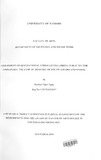| dc.description.abstract | The main aim of this study was to assess occupation stress levels among public sector employees in Ministry of Youth Affairs and Sports. The study was set to achieve the following specific objectives namely; to determine the various prevalent sources of stress as experienced by employees within the Ministry; determine the levels of stress by social demographic characteristics (age, gender, length of service and position) of employees in the Ministry and; determine the effects of stress on job performance among the employees in the Ministry. The study adopted descriptive research design. The target population was to be all 469 employees in Nairobi (Headquarters); Ministry of Youth and Sports.
A total of 140 respondents were randomly sampled from all levels in the Ministry (top-level, middle level, low-level management and support staff). This constituted 30% of the total population. The study used primary data collected from stratified random sampling of target sample population. Structured questionnaires consisting of both open and closed questions were principal instruments in collecting primary data. Secondary data was obtained from work plans and set target reports, which were accessed from Human resource department, on request. The raw data from the field was then analyzed using statistical package for social sciences (SPSS) and MS excel. Both descriptive and inferential statistics were used in interpretations of findings. Descriptive tools that included percentages and frequencies were used.
Study findings revealed that majority of the respondents indicated poor communication of roles and responsibilities in the organization (57.3%) and low job motivation due to unequal reward (50.7%) as major sources of stress. Other noted sources (of stress) by respondents were as follows; lack of promotion in the workplace (49%), conflicting job roles (34.8%), lack of role clarity (47.1%), working conditions (43.4%), workload (44.4%) and organizational management styles (43.5%). It was observed that much of stress sources experienced workplace related. According to Murphy (1995), the sources of stress in this study can fit the following classifications: Role in the by respondents were organization, Career development and Organizational structure / climate. On a low and no extent, respondents attributed stress to harassment at workplace (71.8%) and also cited workmates' relations (53%) as not a significant source of their stress.
Most of the stress sources identified in the study were highly attributed to the organizational factors intrinsic in the Ministry itself. Employees less cited personality and work -family related factors as contributing to their stress. It was observed that the workforce in the study organization endured different levels of stress. The stressors contributing to this were largely organizational specific. Only a small proportion of these stressors emanated from other factors that could explain overall occupational stress. Among the most prevalent stressors as identified in the study were; low job motivation, lack of promotion in the workplace, conflicting job roles, lack of role clarity, workload, (workplace) working condition and organization management styles.
The study concludes that respondents suffered from stress as they acknowledged meeting their set work targets with a lot of pressure. Although work environment was favorable as established by the findings, the non-existence of teamwork between groups, lack of respect for employees' opinion by immediate supervisors as well as lack of mechanism for reporting and managing stress coukl be some of factors that might have attributed to the observed stress among employees. Further, socio-demographic characteristics of 'respondents relates differently with individual's stress. The males, the married and the low ranking employees seemed to be more vulnerable to high stress tension levels. Also observed was that respondents above the age 45 (years) had their stress levels considerably above average as compared to the rest of the ages in the study. | en_US |

